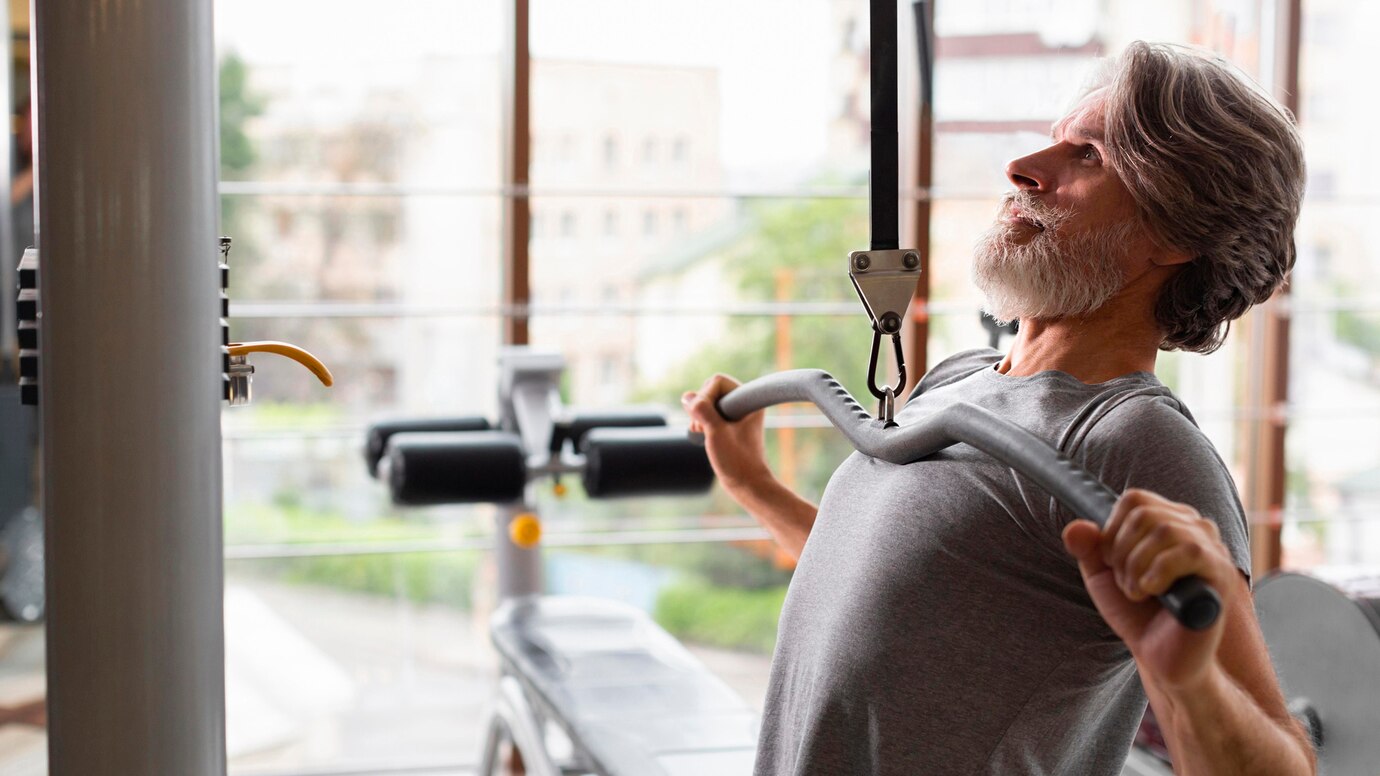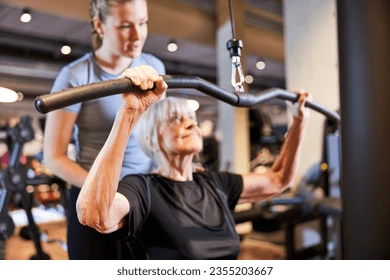Not Just For the Young!
Weight training is not only for young people! Discover the many benefits of weight training for older adults, some of which may surprise you! Older adults benefit from lifting weights and building muscle. In fact, strength training can help prevent or reverse some of the age-related changes in your body, such as loss of muscle mass, bone density, balance, and mobility. Strength training can also improve your mood, cognitive function, and quality of life.
See my related post:
Click Here–> Strength Exercises for Older Adults
But how do you start weight training as an older adult? What are the best exercises and routines for your goals and abilities? How can you avoid injuries and stay motivated? In this blog post, I will answer these questions and give you some tips on how to make weight training a part of your healthy lifestyle.
The Benefits of Weight Training for Older Adults
Weight training has many benefits for older adults, such as:
- Increasing muscle mass and strength. As you age, you naturally lose muscle mass and strength, a condition called sarcopenia. This can affect your ability to perform daily activities, such as climbing stairs, carrying groceries, or getting up from a chair. Weight training can help you preserve or increase your muscle mass and strength, which can make you more independent and functional.
- Improving bone health. Another consequence of aging is the loss of bone density, which can increase your risk of fractures and osteoporosis. Weight training can stimulate bone formation and slow down bone loss, which can protect your bones from breaking and improve your posture.
- Enhancing balance and mobility. Weight training can also improve your balance and mobility, which can prevent falls and injuries. By strengthening your muscles and joints, weight training can improve your stability and coordination, as well as your range of motion and flexibility.
- Boosting metabolism and weight management. Weight training can also help you burn more calories and fat, even at rest. This is because muscle tissue is more metabolically active than fat tissue, meaning it requires more energy to maintain. By increasing your muscle mass, weight training can boost your metabolism and help you maintain a healthy weight.
- Improving mental health and well-being. Weight training can also have positive effects on your mental health and well-being. By lifting weights, you can release endorphins, which are natural chemicals that make you feel good. Increased activity will increase blood flow meaning that more oxygen is getting into your brain. Correspondingly, weight training can also reduce stress, anxiety, depression, and improve your self-esteem and confidence. You will look and feel better!

The Best Approach to Weight Training for Older Adults
Now that you know the benefits of weight training for older adults, how do you start? Here are some general guidelines to follow:
- Consult your doctor before starting any exercise program, especially if you have any medical conditions or injuries that may affect your ability to exercise safely. That being said, I have severe arthritis in my right wrist but, if I am careful I can use a 5lb. dumb-bell and do various exercised with it.
- The importance of starting slowly cannot be overemphasized. Gradually increase the intensity, frequency, and duration of your workouts. Don’t try to lift too much weight or do too many repetitions at once. Listen to your body and stop if you feel any pain or discomfort.
- Warm up before each workout by doing some light cardio exercises, such as walking, cycling, or jogging, for 5 to 10 minutes. This will increase your blood flow and prepare your muscles and joints for lifting weights.
- Choose exercises that target all the major muscle groups in your body, such as arms, legs, chest, back, shoulders, and core. You can use free weights (such as dumbbells or barbells), resistance bands, machines, or your own body weight (such as push-ups or squats) as resistance.
- Perform 2 to 3 sets of 10 to 15 repetitions for each exercise, resting for 1 to 2 minutes between sets. The last few repetitions should be challenging but not impossible to complete with good form. If you can do more than 15 repetitions easily, increase the weight or resistance slightly. If you can’t do at least 10 repetitions with good form, decrease the weight or resistance slightly.
- Focus on quality rather than quantity. Make sure you perform each exercise with proper technique and control. Avoid jerking or swinging the weights or using momentum to lift them. Breathe normally throughout the exercise and exhale as you lift the weight and inhale as you lower it.
- Cool down after each workout by doing some gentle stretching exercises for 5 to 10 minutes. This will help relax your muscles and prevent soreness and stiffness.
- Rest at least one day between workouts to allow your muscles to recover and grow stronger. You can do other types of exercise on your rest days, such as cardio or flexibility exercises.
- Be consistent and patient. Weight training is not a quick fix but a long-term investment in your health and fitness. You may not see results overnight but if you stick with it, you will notice improvements in your strength, endurance, appearance, and well-being.

Some Examples of Weight Training Exercises for Older Adults
Here are some examples of weight training exercises that you can do.
If you are an older adult, you might think that weight training is not for you. However, weight training exercises can have many benefits for your health and fitness, such as improving your muscle strength, bone density, balance, and mobility. Here are some examples of weight training exercises for older adults that you can try at home or at the gym.
- Squats to chair: Stand in front of a sturdy chair with your feet hip-width apart. Slowly lower your hips until you touch the chair, then stand up again. Repeat 10 to 15 times.
- Step-up: Place a low step or a sturdy box in front of you. Step up with your right foot, then bring your left foot up to meet it. Step down with your right foot, then your left foot. Repeat 10 to 15 times, then switch legs.
- Bird dog: Begin on your hands and knees with your back straight and the abs pulled in. Lift the right arm up until it is level with the body and, at the same time, lift the left leg up and straighten it. Hold for several seconds, then lower and repeat on the other side. Do 10 to 15 repetitions on each side.
- Lying hip bridges: Lie on your back with your knees bent and your feet flat on the floor. Lift your hips off the floor until your body forms a straight line from your shoulders to your knees. Squeeze your glutes and hold for a few seconds, then lower and repeat. Do 10 to 15 repetitions.
- Side lying circles: Lie on your right side with your legs stacked and slightly bent. Lift your left leg up a few inches and make small circles in the air with your foot. Do 10 to 15 circles in each direction, then switch sides.
Remember to warm up before you start and cool down after you finish. You can also use light dumbbells, resistance bands, or water bottles to add some challenge to these exercises. Consult your doctor before starting any new exercise program, especially if you have any medical conditions or injuries.
Weight training exercises for older adults can help you stay strong, healthy, and independent. Give them a try and see how they make you feel! Remember to stay hydrated both before and after exercise. Hydration keeps tissue supple and aids in the recovery process after exercise.
I hope you have enjoyed Weight Training for Older Adults! If you have questions or would like to comment, please do so in the comment section below. Finally, additions to this platform are made regularly. If you would like to be notified of updates enter your name and best email in the form below.

Grant Rayner
Today’s fitness tip: Cardiovascular Support at Discount Prices | Click on the Image Below
